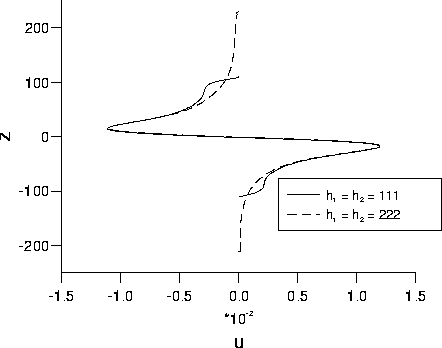Most of the waves simulated have been on a square grid with the interface
near the centre. This means that the depth of the two fluids
![]() and
and ![]() satisfy
satisfy ![]() . Thus
. Thus ![]() and the wave can be considered as being in deep water.
There can, however,
be a finite velocity close to the solid boundaries and a boundary layer
is formed, see for example figure 7-39.
A wave with the same parameters as wave (1), in table 7-1, was initialised
on a grid with twice the height and with the interface at the centre
so that
and the wave can be considered as being in deep water.
There can, however,
be a finite velocity close to the solid boundaries and a boundary layer
is formed, see for example figure 7-39.
A wave with the same parameters as wave (1), in table 7-1, was initialised
on a grid with twice the height and with the interface at the centre
so that ![]() . The wave was allowed to
evolve and the velocity profiles and the frequency and damping
parameter compared to those for wave (1).
The fitted values found for the frequency and the damping parameter
were not found to differ significantly.
The velocity profiles for wave (1) and
for the new wave on the larger grid are shown in figures
7-53 - 7-55. In the interface
. The wave was allowed to
evolve and the velocity profiles and the frequency and damping
parameter compared to those for wave (1).
The fitted values found for the frequency and the damping parameter
were not found to differ significantly.
The velocity profiles for wave (1) and
for the new wave on the larger grid are shown in figures
7-53 - 7-55. In the interface

Figure 7-53: The horizontal velocity u at ![]() ,
, ![]() as a function of z for
wave (1) using two different grid sizes.
as a function of z for
wave (1) using two different grid sizes.

Figure 7-54: The horizontal velocity u at ![]() ,
, ![]() as a function of z for
wave (1) using two different grid sizes.
as a function of z for
wave (1) using two different grid sizes.

Figure 7-55: The vertical velocity w at ![]() ,
, ![]() as a function of z for
wave (1) using two different grid sizes.
as a function of z for
wave (1) using two different grid sizes.
region the horizontal velocities, ![]() and
and ![]() of the wave on the small and large grid respectively, are
consistent for the small and large
grids. The horizontal velocity of the wave on the larger grid has become
negligible within the inviscid region of the fluid and so there is no
evidence of a boundary layer at the solid boundary. The boundary layer
for the wave on the smaller grid can be observed, as before, and the
horizontal velocity is zero on the solid boundary, as expected. Away from the
solid boundary
of the wave on the small and large grid respectively, are
consistent for the small and large
grids. The horizontal velocity of the wave on the larger grid has become
negligible within the inviscid region of the fluid and so there is no
evidence of a boundary layer at the solid boundary. The boundary layer
for the wave on the smaller grid can be observed, as before, and the
horizontal velocity is zero on the solid boundary, as expected. Away from the
solid boundary ![]() increases rapidly and becomes slightly
larger then
increases rapidly and becomes slightly
larger then ![]() outside its boundary layer. This is due partly
to the similar effect observed in figure 6-2 but mainly due
to the different values of
outside its boundary layer. This is due partly
to the similar effect observed in figure 6-2 but mainly due
to the different values of ![]() for the two waves. This is seen
in figures 7-53 and 7-54 at
for the two waves. This is seen
in figures 7-53 and 7-54 at ![]() and
and ![]() respectively.
The results in figure 7-55 show that
respectively.
The results in figure 7-55 show that ![]() and
and ![]() are very similar everywhere except within the
boundary layer of the smaller grid where
are very similar everywhere except within the
boundary layer of the smaller grid where ![]() approaches zero. The
velocity
approaches zero. The
velocity ![]() is also small in this region and reaches zero slightly
further from the interface and no boundary layer is observed at the
solid boundary of the larger grid. In the region between
is also small in this region and reaches zero slightly
further from the interface and no boundary layer is observed at the
solid boundary of the larger grid. In the region between ![]() approaching
zero and
approaching
zero and ![]() we would expect
we would expect ![]() to be zero. In fact,
there
is a small variation observed. This is derived from a small vertical
velocity which is produced at the interface at the beginning of the simulation
when the density is very slightly reduced across the small interface region.
The velocities produced are very small and are generally negligible,
particularly when
to be zero. In fact,
there
is a small variation observed. This is derived from a small vertical
velocity which is produced at the interface at the beginning of the simulation
when the density is very slightly reduced across the small interface region.
The velocities produced are very small and are generally negligible,
particularly when ![]() and the interface is sharp.
and the interface is sharp.
Thus we have seen that increasing the depth of both fluids has a
negligible affect on the frequency and damping parameter.
The velocities are similar near the interface were they
are largest, away from the interface there is only a small
difference in the velocities mainly due to a boundary
layer forming around the solid boundary.